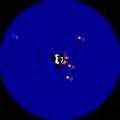Extra Solar Planets
HR 8799
HR 8799 is a young type A5V star (or possibly F0V) between about 20 and 50 million years old, and around 130 light years away from Earth. It is estimated at 1.47 times the mass, and 1.34 times the diameter, of the Sun. It is known to have four massive planets in orbit, which were among the first to be confirmed via direct imaging. It also has both an inner and an outer debris disk around it. The star is a "Gamma Doradus variable" as its luminosity changes because of non-radial pulsations of its surface. Three of the planets (b, c & d) were observed and imaged directly in 2008; the fourth (e) in 2010.
The system is remarkably similar to our own Solar System in that it has four giant planets orbiting at some distance from the primary, as well as two debris disks that mirror our Asteroid Belt and Kuiper Belt. If we observed "our" system from a similar distance, with our current technology, we would probably find the four outer planets (jupiter to Neptune) and possibly the two disks, but would not be able to identify the small, rocky inner planets including Earth, so there may well be small inner planets here yet to be found.
The system is remarkably similar to our own Solar System in that it has four giant planets orbiting at some distance from the primary, as well as two debris disks that mirror our Asteroid Belt and Kuiper Belt. If we observed "our" system from a similar distance, with our current technology, we would probably find the four outer planets (jupiter to Neptune) and possibly the two disks, but would not be able to identify the small, rocky inner planets including Earth, so there may well be small inner planets here yet to be found.
Infra-red photograph taken using a part of the Hale telescope's mirror.
Star HR 8799 is at center. HR 8799d (bottom), HR 8799c (upper right), HR 8799b (upper left). Taken in infra-red light.
Spitzer infrared image of the dust, or debris, disk around HR 8799. In the enlarged image, the small dot at the centre indicates the size of Pluto's orbit around the sun. January 2009.
Images of the HR 8799 System
A picture of the four planets around HR 8799 taken December 8th 2010. Newest planet, HR 8799e, is closest to the star.
Credit & Copyright: NRC-HIA, Christian Marois, Keck Observatory
Credit & Copyright: NRC-HIA, IDPS, Keck Observatory
Here are some details about the planets in sequence from the closest to the star outwards. For comparison, in our system the outer planets are at the following distances (Semi-major axis) from the Sun: Saturn 9½ AU, Uranus 19 AU, and Neptune 30 AU with the Kuiper Belt extending from Neptune's orbit out to about 55 AU.
Planets in the HR 8799 System
| Planet | Description (in order from the star; all quoted values are approximate) |
| Inner Dust Disk | The warm (150ºK) inner dust disk starts at around 5 AU from the star, and extends out to the orbit of the inner planet HR 8799 e. |
| HR 8799 e | This planet was discovered in November of 2010, and while it weighs around 7 to 9 times the mass of Jupiter, it is only about 20% larger in diameter. It is the closest to its parent sun orbiting at about 14½ AU (Astronomical Units; about 2.2 billion km or 1.35 billion miles), with a surface temperature of a balmy 1,000K (727ºC). It completes one orbit in approximately 49.3 years. |
| HR 8799 d | This planet weighs around 5 to 10 times the mass of Jupiter, and is about 20% to 30% larger. It orbits at about 24 AU (3.6 billion km or 2.25 billion miles), and completes one orbit every 100 years or so. |
| HR 8799 c | This planet is very similar in mass and size to HR 8799 d. It orbits further out at about 38 AU (5.6 billion km or 3.5 billion miles), and completes one orbit every 190 years or so. |
| HR 8799 b | This planet weighs a little less at around 4 to 7 times the mass of Jupiter, and between about 10% and 30% bigger. It orbits at about 68 AU (10 billion km or 6.25 billion miles) away from the star, and completes one orbit every 460 years or so. Its surface temperature is a little lower than the other three planets at about 800K to 900K. |
| Outer Dust Disk | The cold (45K) outer dust disk starts a little further out than HR 8799 b at about 75 astronomical units (AU) which is about 11 billion km (7 billion miles). The inner edge is quite sharp, presumably having been defined by the outer planet. It extends outwards well beyond 1,000 AU. Possibly it is separated into two disks; the inner part being the planetissimal disk, out of which the planets formed, with a larger outer disk. |





